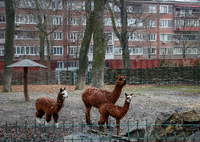The sun shines across the blue sky in the Kyiv zoo on Thursday. In a video message, the zoo director Kirill Trantin thanks for the donations from Berlin. He seems calm, even relaxed, casually leaning against a load of groceries.
Crates full of fruit and vegetables are stacked on top. A forty-second video that gives hope. Due to the numerous donations, it was possible to buy feed and to take care of the animals for another week.
“We bought a variety of fruits and vegetables, fresh fish and meat,” says Trantin. In these difficult times he is grateful for the support. But the harmonious picture is deceptive: the sirens wail in the background. There is still war in Ukraine.
Escape with the pet
There have been many rescue operations since then. Whether lions and tigers from animal shelters or cats and dogs from an animal protection center – animal rights activists get involved. And many Ukrainians are still fleeing the war zone with their pets.
A number of refugees had to leave their four-legged friends behind. Since then, various animal protection organizations have been involved in neighboring Poland, such as the World Animal Protection Society (WTG).
The association supports the Polish organization “Schronisko w Korabievicach Viva” helping to provide first aid for dogs and cats. “We want to pave the way to safety for people and animals together,” explains Wiebke Plasse, Head of Communications at the World Animal Protection Society.
Entry with pets possible
Shortly after the start of the war, the Federal Ministry of Food and Agriculture (BMEL) announced that the EU Commission had asked the Member States to temporarily ease the entry of pets who want to enter the EU accompanied by their owners. The Member States, including Germany, complied with this request.
Since then, pet owners have been able to enter Germany from the Ukraine with their pets until further notice without having to apply for a permit in advance. Information on entry is available in English, Ukrainian and Russian.
However, the animals in Poland are already receiving initial care from the World Animal Protection Society. In addition, EU pet passports are issued, rabies vaccinations and subsequent isolation are ensured. “Unfortunately, the Ukraine still records several hundred cases of rabies in dogs and cats every year,” says Wiebke Plasse from the WTG.
It is therefore important to implement the precautionary measures. Plasse also appealed to the states: “The refugees must be supported in implementing the necessary protective measures for their animals. What counts now is to reconcile quick help with effective animal welfare.”
Zoo animals still in the midst of the turmoil of war
In the Kyiv zoo, on the other hand, the animals continue to persevere. Zoo director Kirill Trantin moved into the zoo with several employees at the beginning of the war to continue caring for the animals. Two weeks ago, Trantin reported that the situation was very stressful for the animals and that some birds were injured because they flapped against the windows.
Therefore, attempts are being made to keep the animals occupied and to give them the opportunity to exercise in the fresh air while the bombs are falling in the background. 200 species and almost 4000 animals live in the zoo – too many for an evacuation.
The Berlin Zoo published the current video message on Thursday evening on its website and on Twitter. The zoo director, who seems relaxed, ends the video with a peace sign. Unfortunately, peace is still a long way off.
